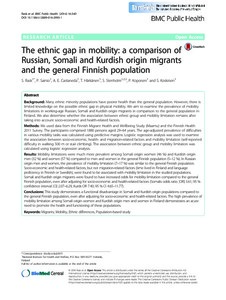The ethnic gap in mobility: a comparison of Russian, Somali and Kurdish origin migrants and the general Finnish population
Rask, Shadia; Sainio, Päivi; Castaneda, Anu E; Härkänen, Tommi; Stenholm, Sari; Koponen, Päivikki; Koskinen, Seppo (2016)
Rask, Shadia
Sainio, Päivi
Castaneda, Anu E
Härkänen, Tommi
Stenholm, Sari
Koponen, Päivikki
Koskinen, Seppo
2016
BMC Public Health 16 1
340
Terveystieteiden yksikkö - School of Health Sciences
This publication is copyrighted. You may download, display and print it for Your own personal use. Commercial use is prohibited.
Julkaisun pysyvä osoite on
https://urn.fi/URN:NBN:fi:uta-201604251475
https://urn.fi/URN:NBN:fi:uta-201604251475
Kuvaus
BioMed Central open access
Tiivistelmä
BACKGROUND:
Many ethnic minority populations have poorer health than the general population. However, there is limited knowledge on the possible ethnic gap in physical mobility. We aim to examine the prevalence of mobility limitations in working-age Russian, Somali and Kurdish origin migrants in comparison to the general population in Finland. We also determine whether the association between ethnic group and mobility limitation remains after taking into account socio-economic and health-related factors.
METHODS:
We used data from the Finnish Migrant Health and Wellbeing Study (Maamu) and the Finnish Health 2011 Survey. The participants comprised 1880 persons aged 29-64 years. The age-adjusted prevalence of difficulties in various mobility tasks was calculated using predictive margins. Logistic regression analysis was used to examine the association between socio-economic, health- and migration-related factors and mobility limitation (self-reported difficulty in walking 500 m or stair climbing). The association between ethnic group and mobility limitation was calculated using logistic regression analysis.
RESULTS:
Mobility limitations were much more prevalent among Somali origin women (46 %) and Kurdish origin men (32 %) and women (57 %) compared to men and women in the general Finnish population (5-12 %). In Russian origin men and women, the prevalence of mobility limitation (7-17 %) was similar to the general Finnish population. Socio-economic and health-related factors, but not migration-related factors (time lived in Finland and language proficiency in Finnish or Swedish), were found to be associated with mobility limitation in the studied populations. Somali and Kurdish origin migrants were found to have increased odds for mobility limitation compared to the general Finnish population, even after adjusting for socio-economic and health-related factors (Somalis odds ratio [OR] 3.61; 95 % confidence interval [CI] 2.07-6.29, Kurds OR 7.40; 95 % CI 4.65-11.77).
CONCLUSIONS:
This study demonstrates a functional disadvantage in Somali and Kurdish origin populations compared to the general Finnish population, even after adjusting for socio-economic and health-related factors. The high prevalence of mobility limitation among Somali origin women and Kurdish origin men and women in Finland demonstrates an acute need to promote the health and functioning of these populations.
Many ethnic minority populations have poorer health than the general population. However, there is limited knowledge on the possible ethnic gap in physical mobility. We aim to examine the prevalence of mobility limitations in working-age Russian, Somali and Kurdish origin migrants in comparison to the general population in Finland. We also determine whether the association between ethnic group and mobility limitation remains after taking into account socio-economic and health-related factors.
METHODS:
We used data from the Finnish Migrant Health and Wellbeing Study (Maamu) and the Finnish Health 2011 Survey. The participants comprised 1880 persons aged 29-64 years. The age-adjusted prevalence of difficulties in various mobility tasks was calculated using predictive margins. Logistic regression analysis was used to examine the association between socio-economic, health- and migration-related factors and mobility limitation (self-reported difficulty in walking 500 m or stair climbing). The association between ethnic group and mobility limitation was calculated using logistic regression analysis.
RESULTS:
Mobility limitations were much more prevalent among Somali origin women (46 %) and Kurdish origin men (32 %) and women (57 %) compared to men and women in the general Finnish population (5-12 %). In Russian origin men and women, the prevalence of mobility limitation (7-17 %) was similar to the general Finnish population. Socio-economic and health-related factors, but not migration-related factors (time lived in Finland and language proficiency in Finnish or Swedish), were found to be associated with mobility limitation in the studied populations. Somali and Kurdish origin migrants were found to have increased odds for mobility limitation compared to the general Finnish population, even after adjusting for socio-economic and health-related factors (Somalis odds ratio [OR] 3.61; 95 % confidence interval [CI] 2.07-6.29, Kurds OR 7.40; 95 % CI 4.65-11.77).
CONCLUSIONS:
This study demonstrates a functional disadvantage in Somali and Kurdish origin populations compared to the general Finnish population, even after adjusting for socio-economic and health-related factors. The high prevalence of mobility limitation among Somali origin women and Kurdish origin men and women in Finland demonstrates an acute need to promote the health and functioning of these populations.
Kokoelmat
- Artikkelit [6140]
